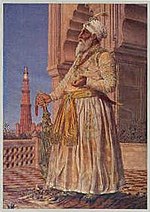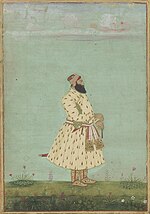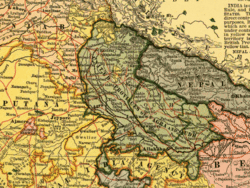Awadh
With the decline of late Mughal Delhi, Awadh became a major source of literary, artistic, religious, and architectural patronage in northern India under the rule of its eleven rulers, called Nawabs.
[6][7][8] Awadh, known as the granary of India, was important strategically for the control of the Doab, a fertile plain between the Ganges and the Yamuna rivers.
Sheik Abdul Rahim later built Machchi Bhawan in this estate; this later became the seat of power from where his descendants, the Sheikhzades, controlled the region.
Nawab –the plural of the Arabic word 'Naib', meaning 'assistant'– was the term given to subahdars (provincial governors) appointed by the Mughal emperor all over India to assist him in managing the empire.
In the absence of expeditious transport and communication facilities, they were practically independent rulers of their territory and wielded the power of life and death over their subjects.
Persian adventurer Saadat Khan, also called Burhan-ul-Mulk, was appointed the Nazim of Awadh in 1722 and he established his court in Faizabad[11] near Lucknow.
The city was "North India's cultural capital"; its nawabs, best remembered for their refined and extravagant lifestyles, were patrons of the arts.
[14] It seems to have been of nearly the same extent as the Province of Oudh at the time of annexation to British India in 1858, and to have differed only in including Gorakhpur, Basti, and Azamgarh, and in excluding Tanda, Aldemau, Rajesultanpur and Manikpur, or the territory to the east and South of Faizabad, Sultanpur and Pratapgarh.
[15] As the Mughal power declined and the emperors lost their paramountcy and they became first the puppets and then the prisoners of their feudatories, so Awadh grew stronger and more independent.
In 1765 he built the Chowk and Tir-paulia and subsequently laid out the Angoori Bagh and Motibagh to the south of it, Asafbagh and Bulandbagh to the west of the city.
The Nawabs graced Faizabad with several notable buildings, including the Gulab Bari, Moti Mahal and the tomb of Bahu Begum.
It is considered to be one of the finest buildings of its kind in Awadh, which was built at the cost of three lakh rupees by her chief advisor Darab Ali Khan.
[16] The Nawabs of Awadh were a Persian Shia Muslim dynasty from Nishapur,[17][18] who not only encouraged the existing Persian-language belle-lettrist activity to shift from Delhi, but also invited, and received, a steady stream of scholars, poets, jurists, architects, and painters from Iran.
Awadh was known as the granary of India and was important strategically for the control of the Doab, the fertile plain between the Ganges and the Yamuna rivers.
He was comprehensively defeated in the Battle of Buxar by the British East India Company, after which he was forced to pay heavy penalties and cede parts of his territory.
Asaf-ud-Daula, the fourth Nawab and son of Shuja-ud-Daula, moved the capital from Faizabad to Lucknow in 1775 and laid the foundation of a great city.
His rule saw the building of the Asafi Imambara and Rumi Darwaza, built by Raja Tikait Rai Nawab Wazir (Diwan) of Awadh, which till date are the biggest architectural marvels in the city.
Saadat Ali Khan was a puppet king, who in the treaty of 1801 ceded half of Awadh to the British East India Company and also agreed to disband his troops in favour of a hugely expensive, British-run army.
The wars and transactions in which Shuja-ud-Daula was engaged, both with and against the British East India Company, led to the addition of Karra, Allahabad, Fatehgarh, Kanpur, Etawah, Mainpuri, Farrukhabad and Rohilkhand, to the Oudh dimensions, and thus they remained until the treaty of 1801 with Saadat Ali Khan, by which province was reduced considerably as half of Oudh was ceded to the British East India Company.
Awadh has been greatly influenced by Mughal cooking techniques, and the cuisine of Lucknow bears similarities to those of Kashmir, Punjab and Hyderabad; and the city is famous for its Nawabi foods.
[24] Their spread would consist of elaborate dishes like kebabs, kormas, biryani, kaliya, nahari-kulchas, zarda, sheermal, Taftan, roomali rotis and warqi parathas.
The events surrounding the 1856 overthrow of Wajid Ali Shah and the annexation of Awadh by the British are depicted in the 1977 film The Chess Players by the acclaimed Indian director Satyajit Ray.
This film is based on famous Urdu story Shatranj Ke Khilari by the great Hindi-Urdu novelist writer Munshi Premchand.














